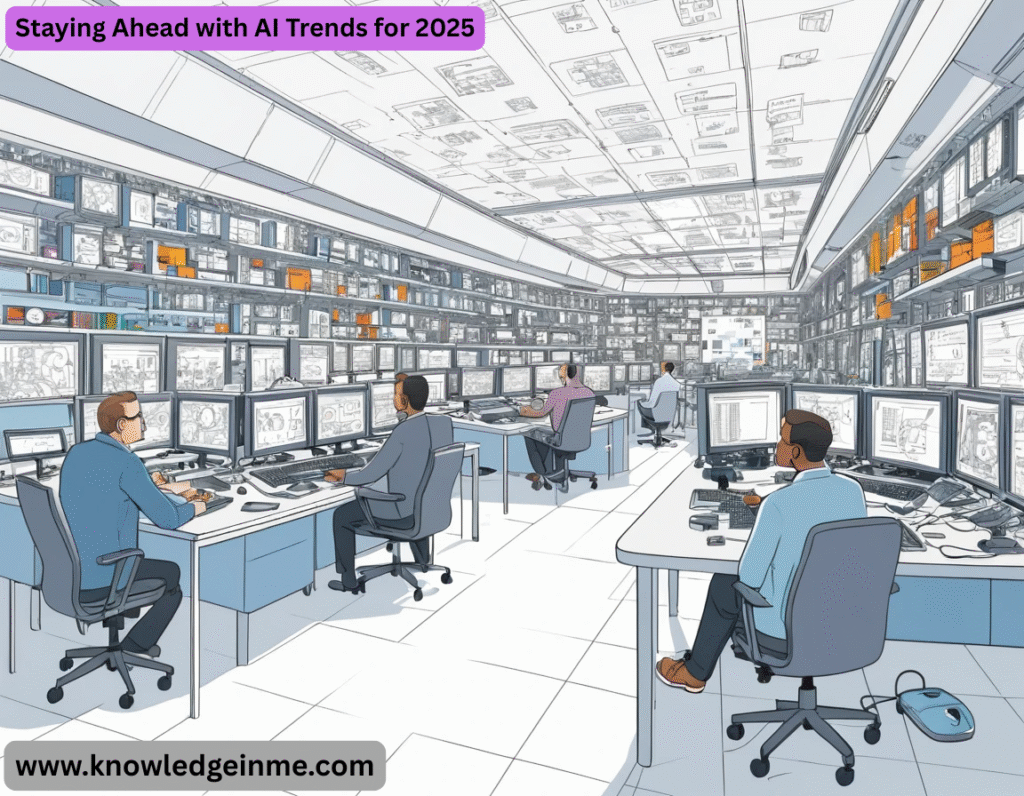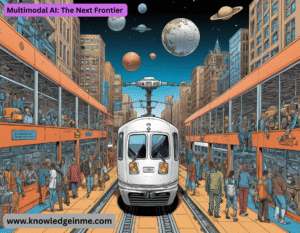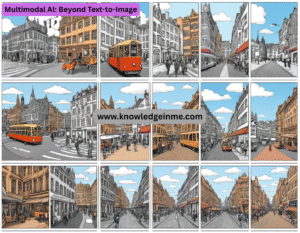Staying Ahead with AI Trends for 2025 Staying ahead of AI trends in 2025 requires understanding emerging technologies, industry shifts, and ethical considerations. Here are the key trends and strategies to keep you at the forefront:
Multimodal AI Dominance
- AI models (like GPT-5, Gemini 2.0) will process text, images, audio, and video seamlessly.
- Applications: Enhanced virtual assistants, real-time translation, and immersive content creation.
Agentic AI & Autonomous Systems
- AI “agents” will perform complex tasks independently (e.g., coding, customer service, research).
- Example: AI project managers coordinating teams or AI lawyers drafting contracts.
Small Language Models (SLMS)
- Compact, efficient models (e.g., Microsoft’s Phi-3, Google’s GEMMA) will rival larger ones.
- Benefits: Lower costs, on-device AI (smartphones, LOT), and better privacy.
AI in Science & Medicine
- Trend: FDA-approved AI doctors and robotic surgeons.
Regulation & Ethical AI
- Stricter global laws (EU AI Act, U.S. AI frameworks) will shape development.
- Focus: Bias mitigation, transparency, and copyright (e.g., AI vs. creative industries).
AI-Native Companies
- Startups will build products where AI is the core, not an add-on.
- Example: AI-first SaaS platforms, generative AI for 3D design.
Quantum AI (Early Stages)
- Real-time threat detection, self-healing networks, and AI vs. AI cyber wars.
How to Stay Ahead
- Upskill: Learn multimodal AI tools (e.g., OpenAI’s Sora, MidJourney v6), agentic workflows, and SLM fine-tuning.
- Experiment: Use no-code AI platforms (Runway, Bubble) to prototype ideas fast.
- Network: Join AI communities (arXiv, Discord groups) and attend conferences (NeurIPS 2025, Google I/O).
Risks to Monitor
- Job Disruption: Roles in content creation, customer support, and coding will evolve.
- Deepfakes & Misinformation: AI-generated media could challenge elections and trust.
- EnergyCosts: Large AI models demand sustainable solutions.
Multimodal AI: The Next Frontier
- Real-time translation will evolve to include tone/sarcasm detection.
Impact:
- Content Creation: Tools like Sora (video generation) + Claude (scripting) will automate filmmaking.
- Retail: AI shopping assistants will analyze your voice, past purchases, and even facial expressions to recommend products.
How to Prepare:
- Experiment with multimodal prompts (e.g., “Generate a TikTok script using this product image and a Gen-Z tone”).
Agentic AI: Your Digital Workforce
What’s New?
- AI agents will autonomously execute multi-step tasks:
- DevOps Agent: Debugs code, deploys fixes, and emails your team.
- Legal Agent: Drafts contracts, checks compliance, and negotiates terms via email.
- Platforms like Auto GPT, BabyAGI, and DevOps-focused agents (e.g., Microsoft’s Auto DEV) will mature.
Impact:
- Productivity: 80% of repetitive knowledge work (e.g., data entry, HR onboarding) could be automated.
- New Jobs: “AI Agent Managers” to oversee workflows.
How to Prepare:
- Test AGENTIC workflows (e.g., Chat GPT’s “Advanced Data Analysis” for Excel automation).
- Study AI orchestration tools (Lang Chain, Llama Index) to chain AI tasks.
Small Language Models (SLMS): Faster, Cheaper, Smarter
Why It Matters:
- SLMS (e.g., Mistral 7B, Phi-3) rival GPT-4 but run on smartphones (offline AI).
Use cases:
- On-device AI: Real-time transcription, personal ized tutoring.
- Privacy-first apps: Medical diagnosis without cloud dependency.
How to Leverage:
- Fine-tune SLMs for niche tasks (e.g., legal document review using Hugging Face).
- Watch Apple’s AI push (SLMs in iOS 19 for Siri upgrades).
AI in Science: Accelerating Discovery
Breakthroughs:
- AlphaFold 3 (DeepMind): Predicts protein-DNA interactions, speeding up drug development.
- AI Lab Assistants: Robots like “Coscientist” (Carnegie Mellon) conduct chemistry experiments autonomously.
Opportunities:
- Staying Ahead with AI Trends for 2025 Biotech startups using AI for personalized medicine (e.g., cancer treatment tailored to your genome).
- Climate Tech: AI designs new materials for carbon capture.
Action Step:
- Follow arXiv’s bioRxiv for AI-driven research papers.
- Explore NVIDIA’s Clara for AI in healthcare.
AI Regulation & Ethics
Key Developments:
- Copyright Battles: Lawsuits over AI training data (e.g., Getty vs. Stability AI).
Strategic Moves:
- Audit your AI tools for bias (use IBM’s Fairness 360 toolkit).
- Plan for AI transparency (e.g., watermarking AI-generated content).
AI-Native Products: Beyond ChatGPT Plugins
Examples:
- AI-first SaaS: A startup that automates A/B testing by simulating customer reactions.
- Generative Design: AI generates 3D product prototypes (e.g., Autodesk’s Fusion 360 + AI).
How to Compete:
- Build vertical AI (e.g., an AI tailor for fashion e-commerce).
- Use no-code AI (Bubble, Softr) to prototype fast.
Quantum AI: Early but Promising
2025 Outlook:
- Hybrid models: Quantum + classical AI for optimization (e.g., supply chain logistics).
- Companies to Watch: Google Quantum AI, IBM’s Qiskit, startups like Rigetti.
Action Item:
- Learn basics of quantum machine learning (Coursera’s Quantum Computing Fundamentals).
AI vs. AI Cyber security Wars
Threats:
- AI phishing: Deepfake voices mimicking CEOs to authorize payments.
Protect Your Business:
- Adopt AI-powered SIEM (e.g., Microsoft Sentinel).
- Train staff on AI-driven social engineering threats.
Bonus: Underrated Trends
- Neuro morphic Chips: Hardware that mimics the brain (Intel’s Loihi 3) for ultra-efficient AI.
- AI for Mental Health: Chatbots like Woebot provide CBT therapy (FDA-approved in 2025?).
Multimodal AI: Beyond Text-to-Image
Technical Deep Dive:
- Unified Embedding Spaces: Models like OpenAI’s CLIP and Google’s UnifiedIO map text, images, and audio into a shared vector space, enabling cross-modal retrieval (e.g., search for a product by describing its sound).
- Real-Time Video Synthesis: Tools like Pika 2.0 and Stable Diffusion 3 will generate interactive video (e.g., change an actor’s outfit mid-scene via voice command).
Niche Applications:
- Industrial Maintenance: Upload a video of machinery, and AI diagnoses faults via audio vibrations + visual wear.
Actionable Steps:
- Experiment with multimodal RAG (Retrieval-Augmented Generation) using LlamaIndex to build a Q&A system over your company’s PDFs, images, and meeting recordings.
Agentic AI: From Auto GPT to Enterprise Agents
Technical Deep Dive:
- Recursive Self-Improvement: Agents will use LLM self-reflection (e.g., “Did my code work?
- Swarm Intelligence: Multiple agents collaborate (e.g., one researches, one writes, one fact-checks).
Niche Applications:
- Personalized Education: An AI tutor creates custom lesson plans, generates worksheets, and adjusts based on student frustration detected via webcam.
- DeFi Trading Bots: AI agents execute trades based on SEC filings sentiment + Twitter trends + on-chain data.
Actionable Steps:
- Staying Ahead with AI Trends for 2025 Build a no-code agent with Smol Developer (auto-generates code from specs) or GPT Engineer.
- Monitor open-source agent frameworks (e.g., CrewAI, Microsoft Autogen).
Small Language Models (SLMs): The Edge AI Revolution
Technical Deep Dive:
- Mixture-of-Experts (MoE): Models like Mistral 8x7B activate only subsets of neurons per task, cutting compute costs by 80%.
- On-Device Fine-Tuning: Apple’s MLX lets you retrain SLMs on iPhones using private data.
Niche Applications:
- Farm AI: A smartphone app identifies crop diseases offline via SLM + camera.
- Privacy-Preserving Healthcare: Diagnose rare diseases on encrypted patient data without cloud uploads.
Actionable Steps:
- Explore TinyML (TensorFlow Lite for microcontrollers) for IoT AI.
AI in Science: The New Lab Partner
Breakthroughs:
- Self-Driving Labs: AI + robotics (e.g., Tesla’s Optimus) conduct 10,000 chemistry experiments/day.
- AI Peer Review: Tools like Scite.ai check scientific papers for flawed methodology.
Niche Applications:
- Materials Science: AI designs room-temperature superconductors via reinforcement learning.
Actionable Steps:
- Partner with AI-native research platforms (e.g., Emergent Research).
AI Regulation: What’s Enforceable in 202
Under-the-Radar Risks:
- AI Liability Insurance: Mandatory for companies using generative AI (e.g., if your AI chatbot gives harmful advice).
- Data Provenance Laws: Require documenting training data sources (killswitch for many open-weight models).






